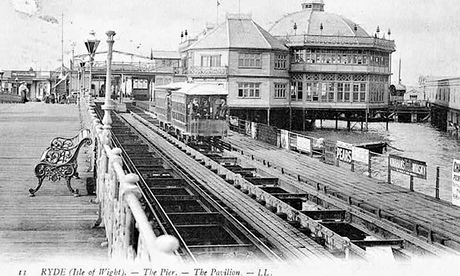
In 1906, Clacton pier offered pretty much every delight the holiday heart could yearn for. The photographer captured smartly dressed people approaching the immaculately painted entrance to consider the rival offers of "bathing, dancing and fishing", an American soda fountain with cream ices, "coffee specialists" in the Blue Lagoon Lounge, motor launch trips, entertainments in the pavilion, and "elaborate prizes" for "the most fascinating game Skeeball".
Tickets to London were also on sale via the paddle steamer Belle – captured in the photograph coming in to moor at the pier head – but really, why would anyone want to leave the Essex resort?
This month a British seaside institution, as much a part of the traditional seaside holiday as a fish supper and a 99 cone, celebrates its 200th birthday: on 26 July 1814 the pier at Ryde on the Isle of Wight opened.
There were earlier piers, built for fishing and freight, and Jane Austen – who holidayed at Lyme Regis in 1804 – used a tumble during a walk along the town's famous Cobb as a crucial plot point in her novel Persuasion.
However, the authors of a new history of seaside piers, Anthony Wills and Tim Phillips of the National Piers Society, rate Ryde as the first seaside pier. It was originally built as a landing stage to get pleasure boat passengers on to dry land at low tide, without having to paddle or be carried, but it was rapidly adopted by landlubbers for the new thrill of walking out to sea suspended above the waves.
It was part of a new world created by the Victorians, Phillips says. "The health giving climate of the seaside gave rise to a brand new industry, centred on getting away from the drudgery of industrial work. The pier was a major contributor, first allowing travellers to disembark and, later, escape into a fantasy world created by the pier owners."
Changing fashions, weather, fire, and the intimidating cost of maintenance, have destroyed many piers. The South Parade pier in Southsea, gutted in 1904 by a fire started by a fisherman's cigarette, and again in 1974 during the making of Ken Russell's film of the rock opera Tommy, has been closed since 2012. Only a few spikes remain of Brighton's storm and arson-ravaged West Pier, once regarded as the most beautiful in the country. The Victoria pier in Colwyn Bay, so busy in 1936 that the council introduced a 2d toll "to prevent indiscriminate lounging", has been closed since 2008.
Ryde pier, wistfully remembered from childhood by the author and former Tory MP Gyles Brandreth as "the first in my life", has reverted to its original function as the drab landing stage for Isle of Wight ferries, but at its height it had a 700-seat domed pavilion, reading and refreshment rooms, and a sun lounge. Many other piers survive only as shadows of their former glory: Saltburn, the only survivor of the six Yorkshire piers, was badly damaged by storms on eight occasions, almost destroyed by a china clay boat which crashed into it in 1924, and at 206m is less than half its original length.
Clacton pier, however, has continued to flourish. In the 1930s a local business man, Ernest Kingsman, spent the fabulous sum of £200,000 modernising it, adding the Ocean Theatre where stars including George Robey and Stanley Holloway topped the bill, and Bertram the Clown and His Bright Young Things packed in thousands of children.
Like most piers it was chopped in half in the second world war, in the paranoid conviction that invading Germans would make use of them, storming past the candyfloss stalls and the swing boats to conquer Britain.
Unlike the sad roll call of lost piers, it reopened after the war under the slogan "Clacton Pier for Healthy Happiness". It flourishes to this day, now billed as "a great British day out in Essex", despite the loss in 1978 of the Ocean Theatre – only five pier theatres remain in the UK – and more damage in storms in 1979 and 1987. It is described by the authors as ""the ultimate candyfloss pier" - and still even offers paddle steamer trips to London.
• British Seaside Piers, Anthony Wills and Tim Phillips, published by English Heritage

